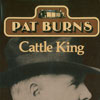Trader Burns
 Pat Burns
Pat Burns
Cattle King
Copyright 1979 Western Producer Prairie Books
200 pages,
ISBN 088833-010-3 (cl).
ISBN 088833-010-9 (pa).
Then there was a new trend. Pat Burns was giving more of his attention to the shipping of pigs, really pioneering in this aspect of the business. Pigs could not be driven overland to market like cattle in prerail years, and consequently they were not marketed far from home. But now, in 1886, the pork producers saw hope in rail shipments and Burns was the one to test it.
On February 19, 1886, he was reported as shipping a carload of pigs from Minnedosa to Winnipeg. A similar shipment was reported on May 14 and then, on August 6, the news told that "Mr. P. Burns, the cattle dealer, was in town this week purchasing hogs for the Montreal market. He was making up six carloads.""
Obviously, he now had bank credit and this was the first shipment of its kind from the West to the East. Indeed, it was being made so soon after the completion of the transcontinental railway the shipping company did not have a freight tariff for pigs being moved that far. But Burns talked to the railway officials and gained their approval for an experimental shipment with tentative freight rates. It was clearly understood that in the event of a loss by the shipper - meaning Burns he would be entitled to apply for a refund up to the total cost of freight.
The pigs were shipped, six carloads, and about three weeks later, Burns paid a call at the freight offices to report succinctly that no refund would be requested. He was on his way west to recruit another shipment of pigs for the eastern trade and the movement grew.
Burns was always in a hurry, as much of a hurry as his short limbs would allow, but never too hurried for a friendly exchange of greetings, either on the street or on a country trail, and so it was when he and Harry Mullins - later Senator Harry Mullins - chanced to meet on a lonely prairie trail between Minnedosa and Rapid City. Mullins, who was born in England and attended school in Lindsay, Ontario, knew the Burns family at Kirkfield and remembered buying sheep from Pat's father. About five years younger than Pat, he had seen active service in the Northwest Rebellion and was to see much more action in the realm of public service.
The meeting on the trail turned out to be a happy reunion. Burns was driving a team of oxen - "as slow as molasses in January" - and leading a small red two-year-old heifer which he was taking to Minnedosa with the idea of selling to John Wake who had just opened Minnedosa's first butcher shop. Mullins, who gained distinction as a breeder, buyer, and exporter of cattle, was interested in the young cow, almost as much as its owner, and conversation rather naturally turned to values. Burns figured the heifer would net him thirty dollars at Minnedosa; Mullins was less optimistic and postulated a weight of 700 pounds at four cents a pound and an extra dollar for the hide - a total return of twenty-nine dollars. One dollar separated the appraisals of two of the best judges of cattle values the country was to know.
In a reminiscent moment, years later, Senator Mullins said: "I sold Pat Burns the five thousand cattle on the Walrond Ranch in less time than it took to settle the value of that little heifer when we met on the Minnedosa trail more than fifty years ago.""
Mullins was manager of the big Cochrane spread when it was sold to the Mormon church in 1904. Later, he sat in the Canadian House of Commons, representing the constituency of Marquette in Manitoba, and still later, in 1935, he was appointed to the Canadian Senate, to sit beside his fellow cattleman, Senator Patrick Burns.
Pat's withdrawal from the Clanwilliam farm was gradual at first, and then when the meat contracts took him far away, it was complete. He loved that farm and loved the community but it became ever clearer that neither the district nor the farm could contain him. Still, he was reluctant about parting with the land holding so many rich memories, and he resolutely refused all offers from prospective purchasers until years after he was established in Alberta. Moreover, he resolved firmly that he would be discriminating in the person permitted to purchase. The buyer, as it turned out, was a MacPherson.
Pete MacPherson from Lorneville, Ontario, cousin of Pat's former neighbors, Jim and Hugh MacPherson, came to Manitoba in 1889 and ten years later bought the Burns land. The Land Titles Office records show the transfer of title on both quarters being registered on June 16, 1899, from Patrick Byrne to Peter R. A. MacPherson, at a price of $1,000 for each quarter.










